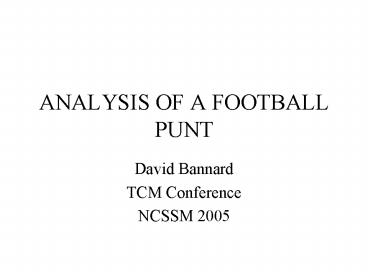ANALYSIS OF A FOOTBALL PUNT PowerPoint PPT Presentation
1 / 20
Title: ANALYSIS OF A FOOTBALL PUNT
1
ANALYSIS OF A FOOTBALL PUNT
- David Bannard
- TCM Conference
- NCSSM 2005
2
Opening thoughts
- Watching St. Louis, Atlanta playoff game, the St.
Louis punter punts a ball. - At the top of the screen a hang-time of 5.1 sec.
is recorded. - In addition, I observed that the ball traveled a
distance of 62 yds.
3
What questions might occur to us!
- How hard did he kick the ball?
- Asked another way, how fast was the ball
traveling when it left his foot? - At what angle did he or should he have kicked the
ball to achieve maximum distance? - How much effect does the angle have on the
distance?
4
More Questions
- How much effect does the initial velocity have on
the distance? - Which has more, the angle or the initial V?
- What effect does wind have on the punt?
5
Initial Analysis
- Most algebra students have seen the equation
- Suppose we assume the initial height is 0.
- When the ball lands, h 0, so we have
- In other words, a hang-time of 5.0 sec. Would
result from an initial velocity of 80 ft/sec
6
Is This Solution Correct?
- Note that this solution only considers motion in
one dimension, up and down. - The graph of this equation is often
misunderstood, as students often think of the
graph as the path of the ball. - To see the path the ball travels, the x-axis must
represent horizontal distance and the y-axis
vertical distance.
7
Two dimensional analysis
- Using vectors and parametric equations, we can
analyze the problem differently. - We will let X(t) be the horizontal component,
I.e. the distance the ball travels down the
field, and Y(t) be the vertical component, the
height of the ball. - Both components depend on the angle at which the
ball is kicked and the initial V.
8
Vector Analysis
- The horizontal component depends only on V0t and
the cosine of the angle. - The vertical component combines v0t sinq and the
effects of gravity, 16t2.
Initial Velocity V0
Y(t)16t2V0t sinq
q
X(t)V0t cos q
9
Calculator analysis
- In parametric mode, enter the two equations.
- X(t)V0t cos q Wt where W is Wind
- Y(t)16t2V0t sin q H0 where H0 is the initial
height. - However we will assume W and H0 are 0
10
Initial Parametric Analysis
- Suppose that we start with t 5 sec. and V080
ft./sec. - We need an angle, and most students suggest 45
as a starting point. - These values did not give the results that were
predicted by the original h equation. - Try using a value of q90.
11
Trial and Error
- Assume that the kicking angle is 45. Use trial
and error to determine the initial velocity
needed to kick a ball about 62 yards, or 186
feet. - What is the hang-time?
12
New Questions
- 1) How is the distance affected by changing the
kicking angle? - 2) How is the distance affected by changing the
initial velocity? - 3) Which has more effect on distance?
13
Data Collection
- Collect two sets of data from the class
- Set 1 Hold the velocity constant at 80 ft/sec.
And vary the angle from 30 to 60. - Set 2 Hold the angle constant at 45 and vary
the velocity from 60 ft/sec to 90 ft/sec.
14
Accuracy
- Accuracy will improve by making delta t smaller.
Dt 0.05 is fast. Dt 0.01 is more accurate. - Do we wish to interpolate?
- First estimate the hang-time with Dt 0.1
- Use Calc Value to get close to the landing place.
- Choose t and X at the last positive Y.
15
Using a Spreadsheet to collect data.
16
Algebraic Analysis
- Can we determine how the distance the ball will
travel relates to the initial velocity anf the
angle. In particular, why is 45 best?
17
- X(t) V0t cos q and Y(t) 16t2 V0t sin q
- When the ball lands, Y 0, so
- 16t2 V0t sin q 0 or t (16t V0 sinq) 0
- So t 0 or V0 sinq/16.
- But X(t) V0t cos q
- Substituting gives
- Using the double angle identity gives
18
- Finally, we have something that makes sense.
- If V0 is constant, X varies as the sin of 2q,
which has a maximum at q 45. - If q is constant, X varies as the square of V0.
19
Additional results
- How do hang-time and height vary with q and V0?
- We already know the t V0 sinq/16
- The maximum height occurs at t/2, so
20
Final QuestionIf we know the hang-time, and
distance, can we determine V0 and q?
- Given that when Y(t)0, we know X(t) and t.
- Therefore we have two equations in V0 and q,
namely - X V0t cos q and 0 16t2 V0t sinq.
- Solve both equations for V0 and set them equal.

